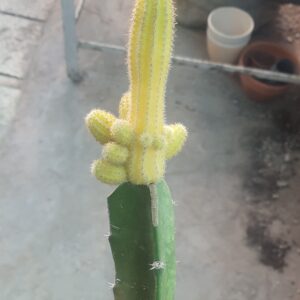Astrophytum is on of the very few varieties in cacti which does not has spines. Astrophytum is famous for its sturdiness and starts to round up with growth. The most common varieties include the white and the green ones with three, four and five sides. You can always message us to ask for your prefered one.
Astrophytum is a genus of cactus that includes several species native to Mexico. These cacti are popular ornamental plants known for their unique shapes and easy care requirements.
Here are 20 headings covering various aspects of Astrophytum:
- Genus overview:
- Astrophytum is a genus of cactus native to Mexico.
- It includes several species known for their unique shapes and easy care requirements.
- Common species:
- Some common species of Astrophytum include A. asterias (sand dollar cactus), A. myriostigma (bishop’s cap cactus), and A. ornatum (peanut cactus).
- Appearance:
- Astrophytum cacti have a variety of shapes, including spherical, cylindrical, and flattened.
- They have raised ribs and tubercles, and may have spiny protuberances.
- The plants produce small, yellow flowers in the spring and summer months.
- Care requirements:
- Astrophytum cacti are easy to care for and can be grown indoors or outdoors.
- They prefer bright, indirect sunlight and well-draining soil.
- They should be watered deeply, but allowed to dry out between watering. Overwatering can lead to root rot.
- Pest and disease resistance:
- Astrophytum cacti are generally resistant to pests and diseases.
- However, they may be prone to mealybugs and aphids.
- Temperature tolerance:
- Astrophytum cacti can be damaged by extreme temperature fluctuations.
- They should be protected from frost and extreme heat.
- Propagation:
- Astrophytum cacti can be propagated by seed or by rooting offsets or cuttings.
- Offsets can be removed from the parent plant and replanted in well-draining soil.
- Cuttings can be taken from the stems or pads of the plant and allowed to dry before planting.
- Soil requirements:
- Astrophytum cacti prefer well-draining soil.
- A cactus mix or sandy soil with good drainage is recommended.
- The soil should be allowed to dry out between watering.
- Watering:
- Astrophytum cacti should be watered deeply, but allowed to dry out between watering.
- Overwatering can lead to root rot and other issues.
- The frequency of watering will depend on the humidity, temperature, and light levels in the plant’s environment.
- Sunlight requirements:
- Astrophytum cacti prefer bright, indirect sunlight.
- They should be protected from direct sunlight, which can cause sunburn or fade their colors.
- Fertilizing:
- Astrophytum cacti do not require frequent fertilizing.
- A cactus-specific fertilizer can be applied once or twice a year, according to the manufacturer’s instructions.
- Repotting:
- Astrophytum cacti should be repotted every 2-3 years or when the pot becomes overcrowded.
- They should be repotted in the spring or early summer, using a well-draining cactus mix.
- The new pot should be only slightly larger than the old one.
- Pruning:
- Astrophytum cacti do not require pruning, but dead or damaged pads can be removed as needed.
- Pruning should be done with clean, sharp scissors or a knife
- Transplanting:
- Astrophytum cacti can be transplanted outdoors in the spring or early summer, after the risk of frost has passed.
- They should be acclimated to outdoor conditions gradually, by placing them in a sheltered spot for a few days before moving them to a full sun location.
- When transplanting, the cactus should be placed in a hole that is slightly larger than its root ball, and the soil should be gently tamped down around the roots.
- Common problems:
- Some common problems with Astrophytum cacti include root rot, sunburn, and pest infestations.
- Root rot can be caused by overwatering or poorly-draining soil.
- Sunburn can be prevented by providing adequate shade and protecting the cactus from direct sunlight.
- Pest infestations can be treated with insecticidal soap or horticultural oil.
- Uses:
- Astrophytum cacti are primarily grown as ornamental plants.
- They are well-suited to a variety of indoor and outdoor environments.
- Some species of Astrophytum have been used in traditional medicine and as a food source.
- Interesting facts:
- Some species of Astrophytum are considered sacred by the indigenous people of Mexico.
- The plants are believed to have spiritual and medicinal properties.
- Astrophytum cacti are prized by collectors and can command high prices on the market.
- Conservation status:
- Some species of Astrophytum are listed as threatened or endangered by the International Union for Conservation of Nature (IUCN).
- Habitat destruction and over-collection are major threats to these cacti.
- Conservation efforts are underway to protect these species and their habitats.
- Cultivation:
- Astrophytum cacti are widely cultivated by cactus enthusiasts and collectors.
- They can be grown from seed, offsets, or cuttings, and are generally easy to care for.
- They are well-suited to a variety of indoor and outdoor environments.
- Popularity:
- Astrophytum cacti are popular ornamental plants known for their unique shapes and easy care requirements.
- They are widely cultivated and sought after by collectors and cactus enthusiasts.
- They make excellent houseplants or garden plants for those who want to add some interest and color to their spaces.
Perfect for your table decor. Care needed for the provision of water and light. Growth depends on the atmosphere, nature and weather.








Reviews
There are no reviews yet.